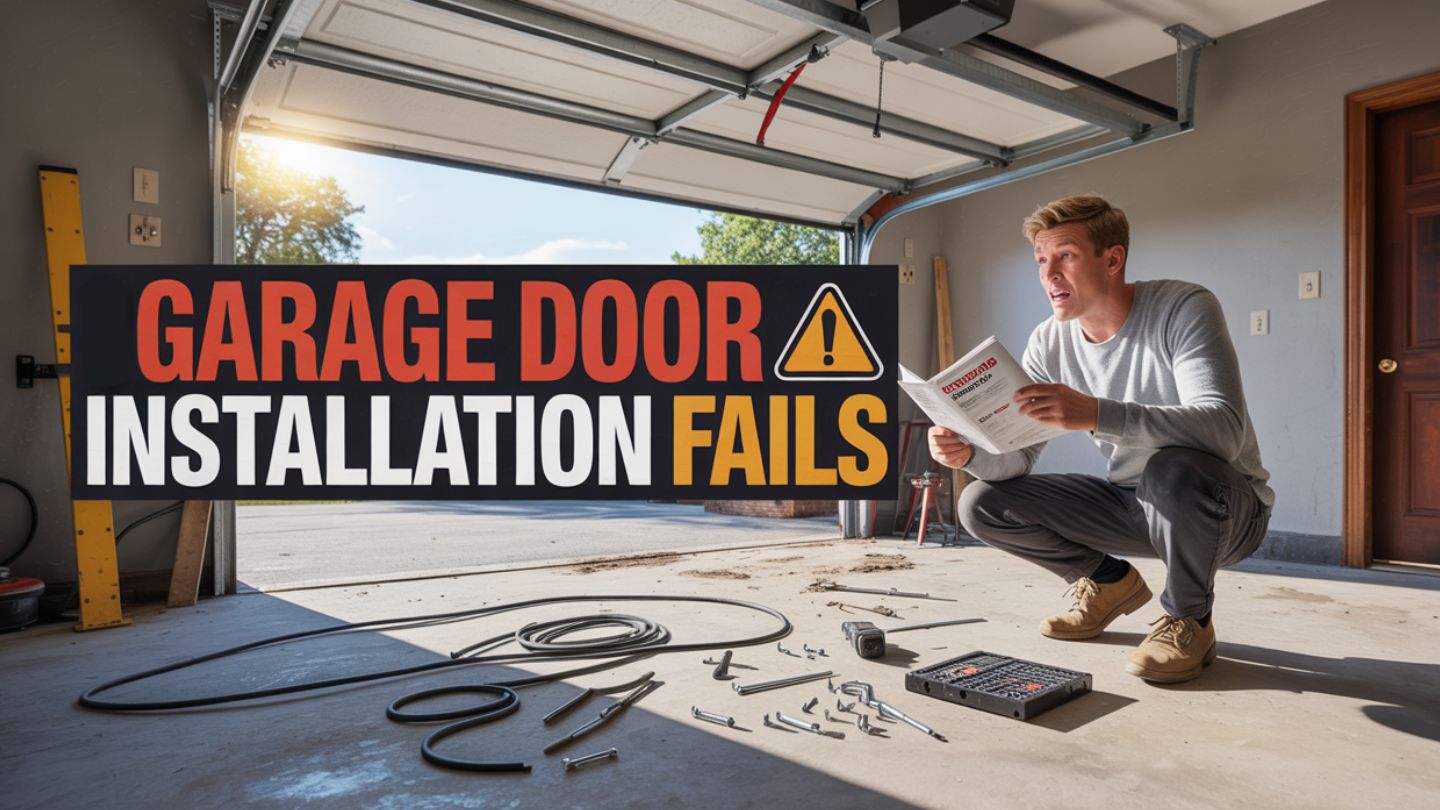
Installing a garage door is a significant home improvement project that demands precision, expertise, and attention to detail. Even minor errors during installation can compromise the door’s performance, safety, and lifespan, leading to costly repairs and potential hazards. Understanding the most common mistakes made during garage door installation helps homeowners and contractors alike ensure a smooth, efficient, and secure setup. This blog outlines the critical missteps to avoid and offers actionable strategies to guarantee a flawless, long-lasting installation.
One of the most common mistakes in garage door installation is neglecting accurate measurements. Precise measurements are the cornerstone of a successful installation, ensuring that the door fits perfectly and operates smoothly. Incorrect measurements can lead to a host of issues, from the door not closing properly to increased wear and tear on the system. It’s not just about measuring the door itself but also considering the door frame and opening size, which we’ll explore in the subsections below.
Curious how long garage door installation takes? Depending on the model, materials, and site conditions, a professional crew can complete the job within 4–8 hours. Unexpected complications, wiring, structural adjustments, or spring calibration can extend the timeline, so always allow for buffer time when scheduling.
When planning for your garage door installation, prioritize precise measurements and proper placement. This foundational step can save you from numerous complications down the road and help maintain the value and functionality of your home. An experienced contractor will often double-check measurements to avoid common errors, a practice we highly recommend for any DIY enthusiast.
The old adage “measure twice, cut once” holds particularly true in garage door installation. Using a reliable tape measure and proper tools is essential for taking precise measurements. Double-checking all measurements before proceeding with the installation can save you both time and money by preventing costly mistakes.
It’s also a good idea to have someone verify your measurements to ensure their accuracy during the installation process. This simple step can make a significant difference in ensuring that everything fits properly and functions as intended, helping you feel confident.
When measuring for your garage door installation, don’t overlook the door frame and door size. Accurate measurements of these components are crucial for a successful installation. Ensuring that the door frame is measured correctly guarantees that the garage door will operate effectively without any issues.
Additionally, accounting for the door frame thickness is essential to ensure a flush fit with the wall, preventing drafts and improving energy efficiency.

Selecting the right garage door is not just about aesthetics; it’s about functionality, durability, and energy efficiency. Choosing the wrong garage door can lead to aggravation and potential dissatisfaction. Lower-cost doors may seem appealing initially, but they can reduce the return on investment and become liabilities over time due to frequent repairs and inadequate performance. It’s essential to consider factors such as:
Want to troubleshoot common garage door issues? Keep an eye out for signs like uneven movement, squeaky rollers, broken springs, or failing sensors. Regular inspections can help detect problems early, before they escalate into costly repairs or safety hazards.
To ensure a proper garage door installation:
This section will delve into matching your garage door with your home’s architecture and evaluating material options to make an informed choice.
A new garage door that aligns with the home’s architecture can significantly enhance the property’s curb appeal. Many homeowners overlook this aspect, but the garage door should complement the home’s design.
Selecting a garage door that reflects the architectural style of the home leads to a cohesive and attractive exterior, which can ultimately increase your home’s value.
The main types of garage door materials are steel, wood, and fiberglass. When choosing a garage door, consider factors such as durability, insulation, maintenance requirements, and how well it matches your home’s architecture. Insulation plays a significant role in improving energy efficiency for garage doors, making it a crucial factor in your decision.
Each material has its pros and cons, so weigh them carefully to find the best fit for your needs.

Ignoring manufacturer guidelines is a recipe for disaster when it comes to garage door installation. These guidelines provide essential details that can prevent costly mistakes and ensure the door functions correctly. Ignoring these specifications can result in performance issues, excessive repairs, and potential safety hazards. It’s not just about the big picture; slight deviations in track alignment or wiring can escalate into significant operational issues over time.
Following the manufacturer’s instructions is crucial for proper installation. This section will explore the importance of adhering to specific instructions and using the recommended tools for a successful installation.
Following specific installation guidelines helps to prevent the potential for improper setup. Manufacturer guidelines include detailed steps and safety precautions that ensure the garage door fits properly and operates smoothly. Ignoring these instructions can lead to safety risks and performance issues, making it imperative to double-check and adhere to every detail provided.
Using the recommended tools is essential for safe and effective installation. Necessary tools for installation include a socket set and a torque wrench for securing hardware correctly. Using the right tools can lead to an unsafe and complex installation process, resulting in improper installation and potential safety hazards.
If you lack the necessary tools, consider buying or renting special tools to ensure a proper installation.
Improper track installation can severely impact the functionality and longevity of your garage door system. To ensure quality installation:
Proper alignment during installation is crucial, as misalignment can cause operational issues and potential damage, leading to increased repair costs and frustration when not in the correct position. Additionally, incorrect installation can exacerbate these problems, especially if components are off-center.
Loose rollers can accelerate wear and tear on both the garage door and its components. This section will focus on ensuring proper alignment and securing tracks firmly to avoid these common pitfalls.
Misalignment of garage door tracks can lead to operational issues and increased wear on the garage door system. Use a level and measuring tape to ensure that tracks are properly aligned during installation. Ensure tracks are level and screws are tightened to confirm a secure installation.
After adjusting tracks for alignment, double-check everything to confirm it’s secure and stable.
Securely fastening tracks with lag screws is essential to maintain their position and ensure the garage door operates without obstruction. This provides a stable guide for the garage door and prevents movement, which is crucial for preventing operational issues and maintaining smooth operation.
Properly secured tracks also enhance the security features of the garage door system.
Spring tension is critical for proper garage door operation, providing the necessary support to counterbalance the door’s weight and ensure a smooth opening and closing motion. Mismanagement of spring tension poses safety hazards and can lead to significant damage, such as the door dropping or malfunctioning entirely. Proper spring tension is vital for the longevity and smooth operation of the garage door, reducing strain on the opener and other parts of the door system.
An imbalanced garage door causes strain on the opener and leads to premature wear and tear on the system. This section will delve into understanding spring types and recommending professional adjustments for safety and accuracy regarding the imbalanced door.
Understanding the differences between torsion and extension springs is essential for proper garage door operation. A torsion spring unwinds as the door opens and lifts the shaft to turn the cable drums, while an extension spring uses pulleys and cables to lift the garage door.
Knowing which type of spring your garage door uses can help you manage spring tension effectively.
Seek professional help for adjusting garage door springs to ensure safety and accuracy. Improperly handling garage door springs can lead to serious injuries such as lacerations and broken fingers.
If unsure about spring tension adjustments, it is advisable to consult the manufacturer’s specifications or seek professional help.

Garage door installation can pose serious risks if safety measures are ignored. Ignoring safety guidelines during installation can pose significant risks to personal safety and property. Improper garage door installation can lead to functionality issues, advanced repairs, and safety risks. Garage door springs can store a large amount of potential energy, making them extremely hazardous when mishandled.
Hiring a professional installer can prevent potential safety hazards that come from improper installation. This section will emphasize the importance of using safety gear and disconnecting the power supply to prevent accidents.
Wearing protective equipment like gloves and goggles is crucial during installation to prevent injuries. Essential safety gear includes gloves and safety glasses, which help ensure personal safety during garage door installation.
Using proper safety gear is crucial to ensure personal safety during successful garage door installation. It is essential to prioritize safety throughout the process.
Before beginning the garage door installation, it’s crucial to disconnect the power from the garage door opener. This step ensures safety during the installation process. Disconnecting the power supply to the garage door opener is necessary to prevent accidental activation during installation.
Safety precautions are critical during garage door installation to prevent accidents and minimize any safety risks.
Ineffective weatherproofing can result in increased energy consumption and potential structural issues. To ensure effective protection for your home, it’s important to follow instructions for weather stripping and insulation. Different materials used for garage doors can influence their durability and maintenance needs.
Proper insulation not only prevents energy loss but also reduces the costs associated with heating and cooling your garage space. This section will focus on installing weather stripping and insulating the garage door to enhance energy efficiency and temperature control.
Utilizing vinyl or rubber weather stripping effectively seals the edges of the garage door, minimizing drafts. This helps prevent energy loss and keeps your garage comfortable in various weather conditions. Weather stripping is a crucial step in the garage door installation project, ensuring that the door functions properly and maintains the energy efficiency of your home.
By installing weather stripping, you can avoid costly repairs and enhance the overall performance of your garage door system.
Insulating your garage door can significantly enhance your home’s energy efficiency and improve temperature control inside the garage. Proper insulation not only prevents energy loss but also reduces the costs associated with heating and cooling your garage space.
Installing weather stripping around the edges of the garage door is a key method to seal gaps and improve insulation effectiveness. Incorporating both insulation and weather stripping can lead to a well-functioning garage door that enhances the overall energy efficiency of your home.
Incorrect garage door opener installation can lead to a myriad of problems, including noisy operation, uneven lifting, and safety hazards. The garage door openers are a crucial component of the system, and improper installation can strain the door mechanism. It is essential to ensure that the installation location allows for unobstructed operation. Additionally, there should be easy access for control.
Protect yourself from garage door repair scams by verifying licensing, requesting itemized quotes, and getting multiple estimates. Beware of high-pressure tactics or offers “just for today.” Doing your homework helps you avoid dishonest contractors and ensures reliable, quality service from trusted professionals.
Secure and correct installation practices are key to avoiding operational issues and ensuring the longevity of your garage door system. This section will cover proper mounting techniques and correct wiring practices to help you achieve a successful installation.
Inadequate mounting can result in increased noise and vibrations. Key mounting requirements include:
Using the correct fasteners is crucial for securely installing the garage door opener. Proper mounting techniques are essential for a smooth and trouble-free operation.
Proper wiring technique ensures smooth and safe operation of the garage door. Electrical safety risks, short circuits, malfunctioning openers, and fire hazards can arise from improper wiring connections during garage door installation. Faulty wiring in the garage door opener can cause malfunctions. It may also result in electrical fires.
Using the wrong wire gauge for garage door wiring can cause resistance, leading to performance issues. A properly rated circuit breaker should be installed to protect the garage door opener from overloads. Correct wiring practices are essential to ensure safety and proper functioning.
Regular maintenance of garage door systems is vital for ensuring safety over time. Regular inspections help ensure the smooth operation of garage doors. Key maintenance and safety tips include:
Following a maintenance checklist for garage doors enhances performance and can save from costly repairs. This section will focus on lubricating moving parts and inspecting safety features to maintain the longevity and functionality of your garage door system.
Regular lubrication of garage door components is essential for maintaining optimal functionality. Lubricating moving parts reduces friction and extends the lifespan of the garage door system. Key parts that should be lubricated include rollers, hinges, and tracks.
Regularly lubricating these components helps maintain smooth and quiet operation, preventing premature wear and tear.
Routine checks on safety features like auto-reverse mechanisms are crucial to ensure they are functioning correctly, preventing accidents. Auto-reverse mechanisms are designed to reverse the door direction if an obstacle is detected, significantly enhancing safety.
To test safety features, regularly activate the garage door, placing an object in its path to verify that it reverses as intended. Neglecting to check safety features can lead to hazardous situations, including injury to people or damage to vehicles.
Garage door installation can be approached as a DIY project, but it often comes with risks and challenges that may not be apparent at first. Hiring a professional for garage door installation ensures that complex issues are handled with expertise and proper equipment. Professionals provide safer and more efficient installation, which can alleviate concerns over potential mistakes. DIY installation can lead to cost savings but may also result in unsafe practices if not approached with caution.
Using incorrect tools during DIY project installation can complicate the process and increase the likelihood of safety hazards. This section will compare the pros and cons of DIY versus professional installation, helping you make an informed decision.
For any complex installations or if there are concerns about handling heavy components, it is recommended to hire a professional. Professionals ensure safe and reliable installation due to their expertise, which reduces the risk of injuries and installation issues.
If someone is uncertain about the garage door installation process or feels unconfident about their DIY skills, seeking professional guidance is advised. Both torsion and extension springs need professional installation to ensure safety and proper functioning.
When considering garage door installation, one must weigh the upfront costs of diy garage door installation against the long-term benefits of hiring a professional. DIY installation can significantly reduce initial expenses as homeowners can save on labor costs.
Professional installation can provide advantages such as warranties, adherence to safety standards, and assurance of a job well done that can prevent future costly repairs. Ultimately, the homeowner should assess their budget, skill level, and the complexity of the installation to determine the best approach for their situation.
Avoiding common mistakes during garage door installation is vital to maintaining a system that’s functional, efficient, and safe. From taking accurate measurements and choosing the right materials to following manufacturer guidelines and ensuring proper alignment, each step plays a critical role in achieving a durable and high-performing garage door. Regular maintenance further extends its lifespan and helps prevent costly repairs.
At Columbus Door Sales, we specialize in garage door installation in Dublin that homeowners can rely on for precision, safety, and long-term reliability. With over 60 years of industry expertise, our team delivers professional installation, repairs, and overhead door solutions tailored to your home’s needs. Serving Columbus, Dublin, Arlington, New Albany, Powell, and Worthington, we ensure every project meets the highest standards of quality and customer satisfaction.
When choosing a garage door, prioritize the material, design, insulation, security features, and its compatibility with your home's architecture to ensure functionality and aesthetic appeal.
It's crucial to adhere to manufacturer guidelines during garage door installation to avoid performance problems and safety risks. This compliance ensures the door functions effectively and safely for long-term use.
Ensure your safety by wearing gloves and goggles, disconnecting the power supply to the garage door opener, and diligently following all safety guidelines. These precautions will help prevent accidents during installation.
It's essential to perform maintenance checks on your garage door at least twice a year, including lubricating moving parts and inspecting safety features to ensure smooth operation. Regular maintenance helps prevent costly repairs and extends the lifespan of your door.
You should hire a professional for garage door installation if the project involves complex tasks, if you're uncomfortable managing heavy components, or if you're unsure about the installation process. This ensures the safety and proper functionality of your garage door.